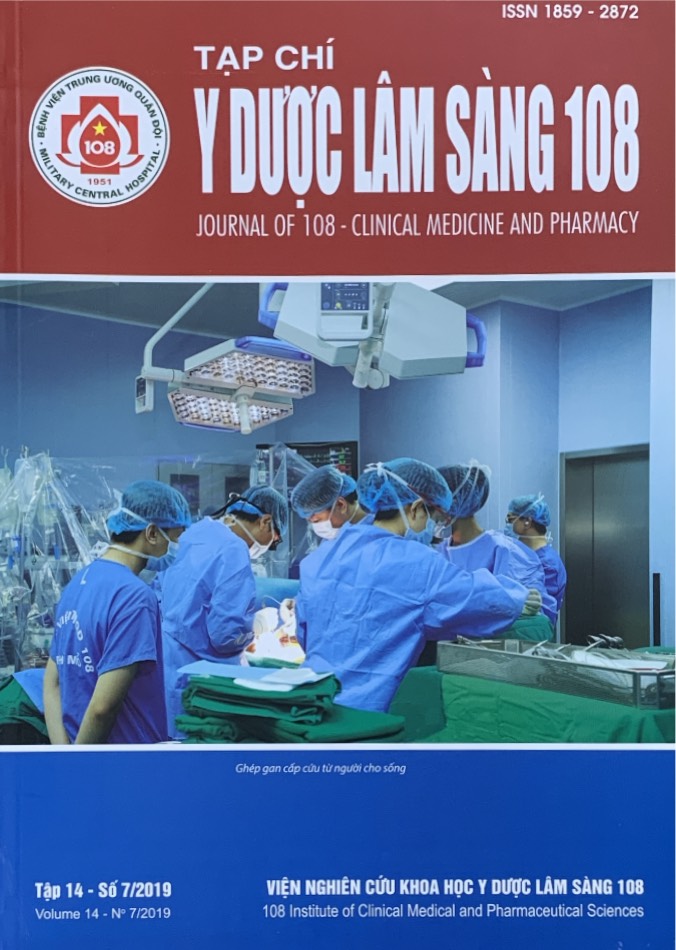Value of MRI in local lymph nodes staging of rectal cancer
Main Article Content
Keywords
Abstract
Objective: Calculating the value of MRI in determining the lymph node metastasis of rectal cancer. Subject and method: 50 patients with definitive diagnosis as rectal cancer, who underwent surgery at 103 Military Hospital and Vietduc Hospital from Mar. 2018 to Feb. 2019. Comparison of N staging by MRI and N staging postoperatively with Kappa and matrix table 2 × 2. Comparison of the number of malignant lymph node on MRI and those postoperatively with ICC. Result: Medium correlation between the number of malignant lymph node on MRI and those postoperatively, ICC = 0.489. Medium correlation between N staging by MRI and those postoperatively, K = 0.486. Overall, accuracy of MRI in N staging were 66%. Conclusion: MRI is moderate for determining N staging of rectal cancer.
Article Details
References
2. Beets-Tan RGH, Lambregts DMJ, Maas M et al (2018) Magnetic resonance imaging for clinical management of rectal cancer: Updated recommendations from the 2016 European Society of Gastrointestinal and Abdominal Radiology (ESGAR) consensus meeting. Eur Radiol 28(4): 1465-1475.
3. Bellows CF, Jaffe B, Bacigalupo L et al (2011) Clinical significance of magnetic resonance imaging findings in rectal cancer. World journal of radiology 3(4): 92-104.
4. UICC (2009) TNM classification of malignant tumours, 7ed, Wiley-Blackwel, Singapore.
5. Gina Brown, Catherine JR, Michael WB et al (2003) Morphologic predictors of lymph node status in rectal cancer with use of use of high-spatial-resolution MR Imaging with histopathologic comparison. Radiology 227: 371-377.
6. Valentini V, Aristei C, Glimelius B et al (2009). Multidisciplinary rectal cancer management: 2nd European Rectal Cancer Consensus Conference (EURECA-CC2). Radiotherapy and oncology: Journal of the European Society for Therapeutic Radiology and Oncology 92(2): 148-163.
7. Iannicelli E, Di Renzo S, Ferri M et al (2014) Accuracy of high-resolution MRI with lumen distention in rectal cancer staging and circumferential margin involvement prediction. Korean J Radiol 15(1): 37-44.
8. Elias AZ, Carolyn R, Stanley RH et al (1996) CT and MR imaging in the staging of colorectal carcinoma: Report of the radiology diagnostic oncology group II. Radiology 200: 443-451.
9. Kim YW, Cha SW, Pyo J et al (2009) Factors related to preoperative assessment of the circumferential resection margin and the extent of mesorectal invasion by magnetic resonance imaging in rectal cancer: a prospective comparison study. World journal of surgery 33(9): 1952-1960.
10. Blomqvist L, Rubio C, Holm T et al (1999) Rectal adenocarcinoma: Assessment of tumour involvement of the lateral resection margin by MRI of resected specimen. Br J Radiol 72(853): 18-23.
11. Ucar A, Obuz F, Sokmen S et al (2013) Efficacy of high resolution magnetic resonance imaging in preoperative local staging of rectal cancer. Molecular imaging and radionuclide therapy 22(2): 42-48.
 ISSN: 1859 - 2872
ISSN: 1859 - 2872
